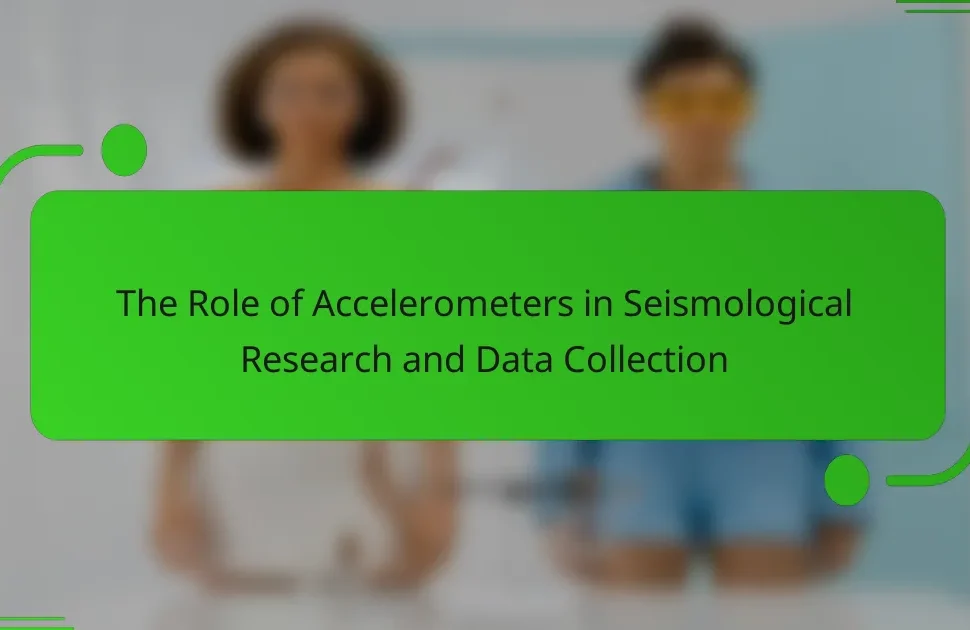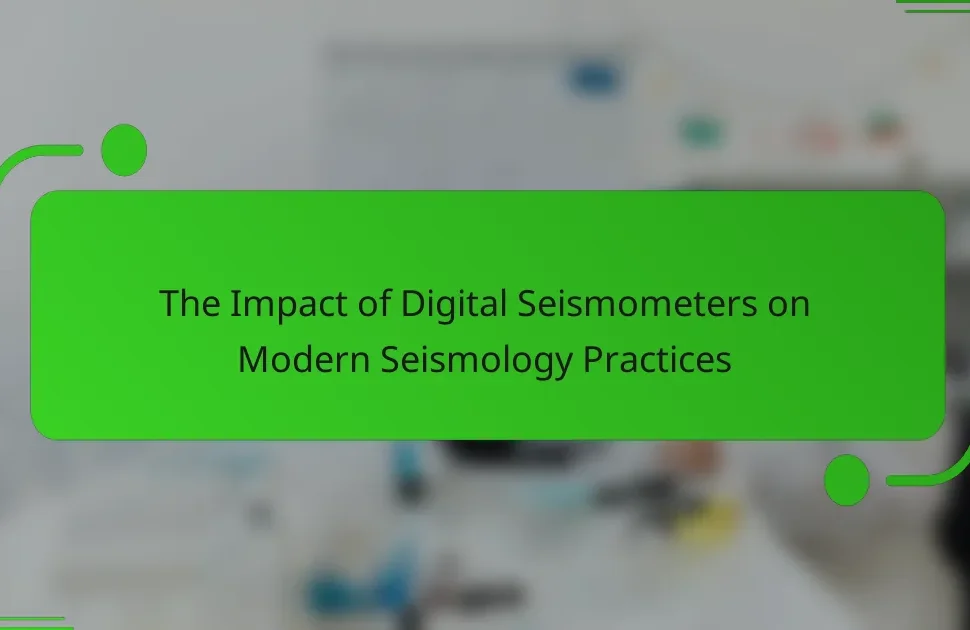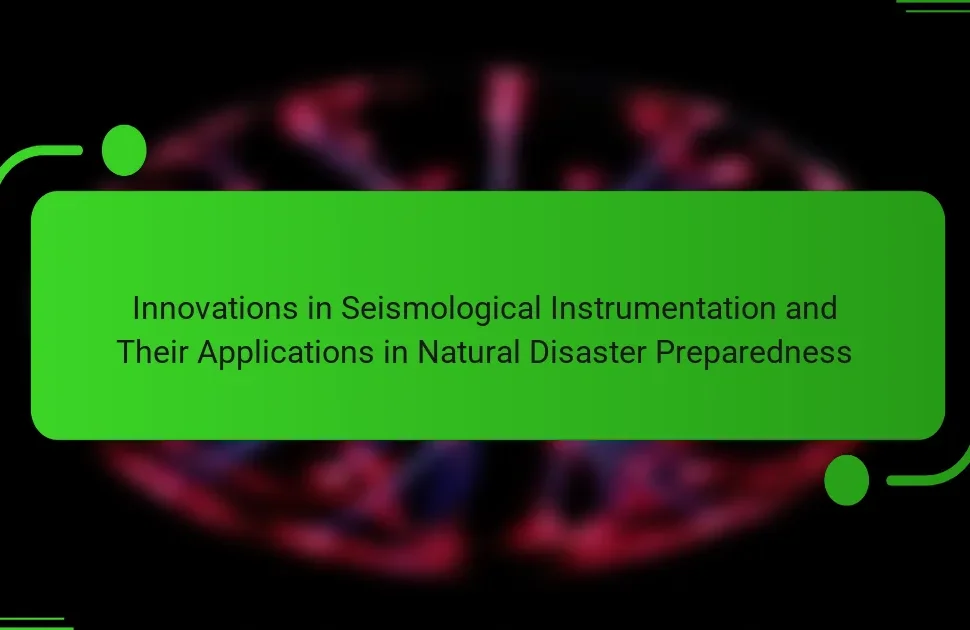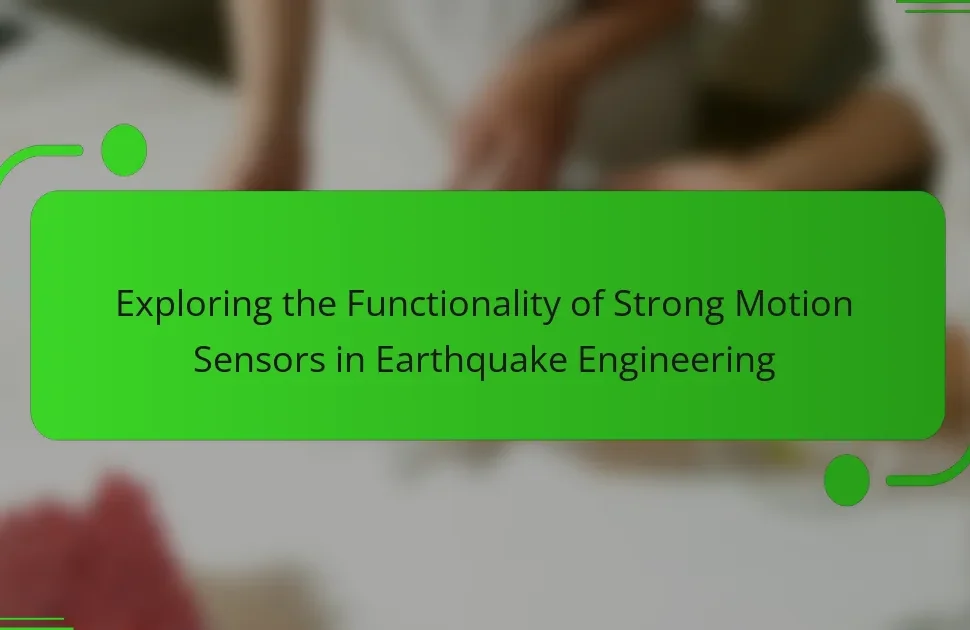GPS systems are satellite-based navigation tools that provide accurate location data, crucial for various applications, including earthquake monitoring. These systems utilize a network of satellites to detect ground movement and shifts in the Earth’s crust, offering real-time data on tectonic activity. By measuring displacements as small as a few millimeters, GPS technology enhances the understanding of fault lines and seismic hazards, thereby improving earthquake forecasting and public safety. The integration of continuous GPS stations and other seismic instruments further increases the reliability and effectiveness of earthquake analysis, enabling scientists to monitor and predict seismic events with greater precision.

What are GPS Systems and Their Role in Earthquake Monitoring?
GPS systems are satellite-based navigation systems that provide precise location data. They use a network of satellites orbiting Earth to determine the exact position of a GPS receiver. In earthquake monitoring, GPS systems play a crucial role in measuring ground movement. They can detect shifts in the Earth’s crust before, during, and after seismic events. This data is vital for understanding tectonic activity and predicting potential earthquakes. Studies show that GPS can measure displacements as small as a few millimeters. This precision aids researchers in assessing fault lines and seismic hazards. Consequently, GPS technology enhances early warning systems and improves public safety during earthquakes.
How do GPS Systems function in real-time monitoring?
GPS systems function in real-time monitoring by utilizing satellite signals to determine precise locations. They receive signals from multiple satellites orbiting the Earth. Each satellite transmits time-stamped data. The GPS receiver calculates its position based on the time it takes for signals to travel. This process allows for accurate tracking of movements and changes in position. Real-time monitoring is crucial for applications like earthquake analysis. It enables rapid data collection and response during seismic events. GPS technology has a precision of a few centimeters in optimal conditions. This accuracy supports effective monitoring and analysis of geological activity.
What technologies are integrated into GPS Systems for earthquake analysis?
GPS systems for earthquake analysis integrate several key technologies. These include satellite-based positioning, real-time data transmission, and geospatial mapping software. Satellite-based positioning allows for precise location tracking of tectonic plate movements. Real-time data transmission enables immediate updates during seismic events. Geospatial mapping software visualizes the data to identify patterns and trends. Additionally, ground-based GPS stations enhance accuracy. They work in conjunction with satellite data to improve monitoring capabilities. These technologies collectively enhance the effectiveness of earthquake analysis and response.
How do GPS Systems collect and process seismic data?
GPS systems collect seismic data by measuring the precise location of ground movement. They utilize a network of satellites that transmit signals to GPS receivers on the Earth’s surface. These receivers calculate their position based on the time it takes for signals to arrive. When an earthquake occurs, the ground shifts, causing changes in the GPS signal’s travel time. This data is processed to determine the magnitude and direction of the seismic event. The National Earthquake Information Center (NEIC) confirms that GPS technology can detect ground displacements as small as a few millimeters. This capability enhances real-time earthquake monitoring and analysis.
Why is real-time monitoring crucial for earthquake analysis?
Real-time monitoring is crucial for earthquake analysis because it provides immediate data on seismic activity. This data allows for timely assessments of earthquake magnitude and location. Accurate real-time information can aid in emergency response efforts. It helps in understanding the dynamics of tectonic movements. Real-time systems can detect ground shaking and send alerts to affected areas. Studies show that rapid data dissemination can save lives and reduce injuries. The United States Geological Survey (USGS) emphasizes that real-time monitoring enhances public safety during seismic events.
What are the potential impacts of timely earthquake data?
Timely earthquake data can significantly enhance disaster response and preparedness. It allows authorities to issue immediate alerts, potentially saving lives. For instance, the 2011 Japan earthquake triggered alerts that helped evacuate thousands before the tsunami struck. Timely data also aids in assessing damage and allocating resources effectively. Research indicates that rapid data dissemination can reduce economic losses by up to 50%. Additionally, timely information supports public awareness and education on earthquake risks. This proactive approach fosters community resilience against seismic events.
How does real-time data enhance emergency response efforts?
Real-time data enhances emergency response efforts by providing immediate information during crises. It allows responders to assess situations quickly and accurately. For instance, during an earthquake, real-time data from GPS systems can pinpoint affected areas. This data helps in prioritizing rescue operations efficiently. Emergency services can allocate resources based on the severity of damage reported in real-time. Studies show that real-time data can reduce response times significantly. Faster responses can save lives and minimize property damage. Overall, real-time data is crucial for effective emergency management.

What are the Key Features of GPS Systems for Earthquake Monitoring?
GPS systems for earthquake monitoring feature high precision, real-time data collection, and continuous tracking. High precision allows for accurate measurement of ground movements, essential for detecting seismic activity. Real-time data collection enables immediate analysis and response to earthquakes. Continuous tracking provides ongoing monitoring of tectonic plate movements. These systems often incorporate a network of GPS stations to enhance data reliability. The technology can detect millimeter-level changes in position. Additionally, integration with other seismic instruments improves overall monitoring effectiveness. These features collectively enhance the ability to predict and analyze earthquakes.
What specific attributes make GPS Systems effective for seismic activity detection?
GPS systems are effective for seismic activity detection due to their high precision and real-time data capabilities. They provide accurate measurements of ground movement, crucial for identifying seismic events. The systems utilize a network of satellites that deliver data with centimeter-level accuracy. This precision allows for the detection of minute shifts in the Earth’s crust. Additionally, GPS systems can operate continuously, providing ongoing monitoring of tectonic activity. They are also capable of transmitting data in real-time, which is essential for timely alerts. Studies have shown that GPS can detect ground deformation before earthquakes occur, enhancing predictive capabilities. The integration of GPS data with other seismic monitoring tools improves overall earthquake analysis and response.
How does accuracy in GPS measurements affect earthquake monitoring?
Accuracy in GPS measurements significantly enhances earthquake monitoring. Precise GPS data allows for accurate detection of ground movement during seismic events. This accuracy helps in determining the location and magnitude of earthquakes. For instance, a study by the U.S. Geological Survey found that high-accuracy GPS can measure ground displacement to within a few millimeters. This level of precision is crucial for understanding fault behavior and predicting future seismic activity. Furthermore, accurate GPS measurements improve real-time data transmission to emergency response teams. This leads to more effective disaster preparedness and response strategies. Overall, the accuracy of GPS directly influences the reliability of earthquake monitoring systems.
What is the significance of data latency in real-time monitoring?
Data latency in real-time monitoring is critical because it affects the timeliness and accuracy of information. High data latency can lead to delayed responses in emergency situations, such as earthquakes. Real-time monitoring systems require minimal latency to provide accurate data for decision-making. For instance, a latency of just a few seconds can significantly impact the effectiveness of disaster response efforts. Studies show that systems with lower latency improve situational awareness and enhance safety measures. Thus, managing data latency is essential for the reliability of real-time monitoring systems.
How do GPS Systems compare to other earthquake monitoring technologies?
GPS systems provide precise real-time data on ground movement during earthquakes. They measure the displacement of the Earth’s surface with high accuracy. This capability allows for immediate analysis of seismic events. Other technologies, such as seismometers, detect ground shaking but may not provide spatial displacement data. Seismometers are excellent for measuring the intensity of shaking but lack the ability to track movement over time.
In contrast, GPS systems can capture both horizontal and vertical movements. This dual capability is crucial for understanding fault dynamics. Studies have shown that GPS can provide insights into the mechanics of earthquakes that seismometers alone cannot. For example, the 2011 Tōhoku earthquake demonstrated how GPS data could reveal surface deformations.
Overall, while both technologies are essential, GPS systems offer unique advantages in monitoring and analyzing earthquake-related ground movement.
What advantages do GPS Systems have over traditional seismic sensors?
GPS systems offer real-time positioning data, which traditional seismic sensors cannot provide. GPS technology allows for continuous monitoring of ground movement. This capability is crucial for detecting subtle shifts before an earthquake occurs. Additionally, GPS systems can cover larger areas compared to localized seismic sensors. They provide precise measurements with centimeter-level accuracy. This accuracy enhances the understanding of tectonic plate movements. Furthermore, GPS systems can operate independently of power sources, unlike some seismic sensors. This independence ensures reliability in remote locations. Overall, GPS systems enhance earthquake monitoring with their comprehensive, real-time data capabilities.
What limitations exist within GPS Systems for earthquake monitoring?
GPS systems have limitations for earthquake monitoring. They can only detect ground movement after an earthquake has occurred. This delay can hinder real-time analysis. GPS accuracy is affected by atmospheric conditions, leading to potential errors. Satellite geometry can also impact the precision of data. Additionally, GPS requires a clear line of sight to satellites, limiting effectiveness in urban areas. The systems may struggle to differentiate between seismic activity and other ground movements. These factors collectively restrict the reliability of GPS for immediate earthquake response.

What are the Applications of GPS Systems in Earthquake Analysis?
GPS systems are used in earthquake analysis to monitor ground movement and deformation. They provide real-time data on tectonic shifts. This data helps scientists assess seismic activity. GPS technology improves the accuracy of earthquake forecasting. It enables precise measurements of fault line behavior. Continuous GPS stations record minute changes in the Earth’s crust. This information is crucial for understanding earthquake mechanisms. Studies show that GPS data enhances models of seismic hazards.
How are GPS Systems used in scientific research related to earthquakes?
GPS systems are used in scientific research related to earthquakes to monitor ground movement. They provide precise measurements of tectonic plate shifts. Researchers analyze these shifts to understand fault lines better. GPS data helps in predicting potential earthquake occurrences. For instance, continuous GPS stations track minute changes in the Earth’s crust. This data is crucial for assessing seismic risk in specific regions. Studies have shown that GPS can detect movements as small as a few millimeters. The information gathered aids in developing early warning systems for earthquakes.
What types of studies benefit from GPS data in seismology?
Studies that benefit from GPS data in seismology include tectonic movement analysis, earthquake early warning systems, and post-earthquake deformation studies. Tectonic movement analysis utilizes GPS to measure the slow movements of tectonic plates. This helps in understanding the strain accumulation along faults. Earthquake early warning systems leverage GPS data to detect ground motion in real-time. This allows for timely alerts before seismic waves reach populated areas. Post-earthquake deformation studies assess changes in the Earth’s surface after seismic events. GPS data provides precise measurements of these changes, aiding in disaster response and recovery efforts.
How do GPS Systems contribute to understanding tectonic movements?
GPS systems provide precise measurements of the Earth’s surface movements. They track the position of points on the Earth with millimeter accuracy. This allows scientists to monitor tectonic plate movements in real-time. GPS data reveals how fast and in what direction these plates are shifting. For example, the North American and Pacific plates are moving past each other at a rate of about 5 centimeters per year. This information helps in understanding strain accumulation along fault lines. As stress builds, it can lead to earthquakes. Therefore, GPS systems are crucial for assessing earthquake risks and improving safety measures.
What are the practical implications of GPS data for urban planning and safety?
GPS data significantly enhances urban planning and safety. It provides accurate location information for infrastructure development. Planners can analyze traffic patterns to optimize road designs. This data helps in identifying high-risk areas for natural disasters. Cities can improve emergency response times using real-time location data. GPS also aids in monitoring land use changes and urban sprawl. Studies show that cities utilizing GPS data can reduce accident rates. For instance, cities like San Francisco have implemented GPS-based systems to improve public safety initiatives.
How can urban areas utilize GPS data for disaster preparedness?
Urban areas can utilize GPS data for disaster preparedness by integrating real-time location tracking and analysis. GPS technology provides precise geographic information, which helps in mapping vulnerable zones. This mapping enables authorities to identify high-risk areas susceptible to disasters, such as earthquakes. Furthermore, GPS data assists in the development of evacuation routes. These routes can be optimized based on current traffic conditions, ensuring efficient evacuations during emergencies. Additionally, GPS can enhance communication systems for emergency responders. By knowing the exact locations of incidents, responders can deploy resources more effectively. Studies have shown that cities using GPS data have improved response times and coordination during disasters. For instance, the use of GPS in the 2010 Haiti earthquake response highlighted its effectiveness in real-time navigation and logistics.
What role does community engagement play in leveraging GPS data for safety?
Community engagement is crucial in leveraging GPS data for safety. It fosters collaboration between local authorities and residents. Engaged communities can provide valuable insights on local hazards. They can also help in data collection and validation. This participation enhances the accuracy of GPS data interpretation. Research indicates that community involvement improves emergency preparedness. For example, the National Academies of Sciences highlighted the role of local knowledge in effective disaster response. Engaged communities can also promote awareness of safety protocols. This collective effort ultimately leads to better safety outcomes during emergencies.
What best practices should be followed when using GPS Systems for earthquake monitoring?
Use high-precision GPS equipment for earthquake monitoring. High-precision systems provide accurate data necessary for detecting minute ground movements. Regular calibration of GPS devices is essential to maintain their accuracy. This ensures that measurements reflect true ground displacement. Implement a network of GPS stations to cover larger areas. A dense network improves data reliability and helps in triangulating earthquake locations. Utilize real-time data processing for immediate analysis of seismic events. This allows for timely alerts and response measures. Regularly review and update monitoring protocols based on technological advancements. Staying current with best practices enhances the effectiveness of earthquake monitoring efforts.
GPS systems are satellite-based navigation tools that provide precise location data, playing a vital role in real-time earthquake monitoring and analysis. This article explores how GPS technology measures ground movement, detects seismic activity, and enhances early warning systems, contributing to public safety. It discusses the integration of various technologies within GPS systems, the significance of real-time data for emergency response, and the advantages of GPS over traditional seismic sensors. Additionally, the article highlights the practical applications of GPS data in urban planning and community engagement for disaster preparedness.




